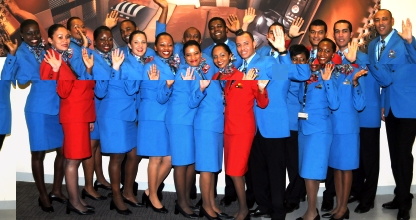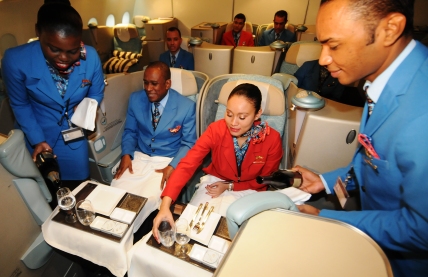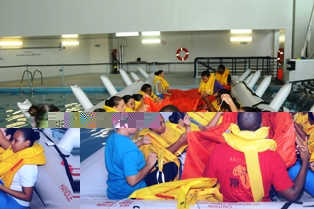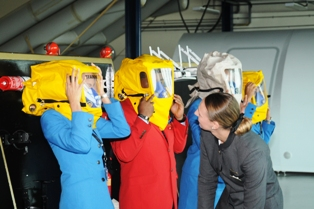Air Seychelles crew set for Airbus take-off |26 May 2012

A typical announcement for such an emergency scenario would run something like this;
“This is an emergency announcement. Cabin crew to your stations. Emergency landing in 15 minutes. Ground has been alerted….Passengers, please remain calm.”
Air Seychelles staff have since several weeks been updating their skills for aviation safety and security, emergency procedures, including fire fighting and First Aid.
Though the 18 Seychellois pilots and the 66 cabin crew (49 women and 17 men) re-training at the Etihad Academy in Abu Dhabi are already qualified, they have to acquire special skills to convert to the Airbus A330.
Each type of aircraft or airline has its own procedures and standards, as confirmed by pilot Cyril Benstrong, who said that he and his colleagues would have had to follow a re-training programme had Air Seychelles acquired the 787 (or Dreamliner).
Meanwhile, our men and women have scored high marks. After all, they are not green, but already savvy in their fields.
If the Etihad Academy has during its short history of eight years trained or re-trained some 2,300 cabin crew from 120 nationalities, the Air Seychelles cabin crew in their bright and colourful uniforms are said to have done spectacularly well, though a few things needed brushing up.
This is confirmed by Aubrey Tiedt, vice-president for Guest Services who told Seychellois journalists last week: “We do not wish to change the personality of Air Seychelles. If anything, the Creole Spirit must be made stronger. They have caught the eyes of everyone by the smiles and colourful uniforms. If that is changed, you lose something.”
Even after they graduate from the Academy, recurrent training in safety procedures is a yearly requirement of the International Civil Aviation Organisation (ICAO). That takes a minimum three days.
To date, two batches of 18 cabin staff have graduated after six weeks of intensive training in aviation safety and service delivery.
The first cohort of 12 women and six men who graduated on Monday, May 7 in the presence of airline chairman, Home Affairs and Transport Minister Joel Morgan and Chief Executive Officer Cramer Ball, are flying Etihad’s airbuses to various destinations, such as Manchester, Dublin and Islamabad to acquire practical experience and build up confidence.
One of them, Shirin Bristol, who has been an air cabin staff for eight years, has returned from Dublin and was looking forward to her next flight, possibly to an Indian city.
That is ahead of the delivery late June of Air Seychelles’ first Airbus 330, presently being painted in the airline’s colours.
“We value on time performance,” said Corporate Affairs manager Alan Renaud. “Everything we’re doing is to send Air Seychelles to a higher level.”
He noted that Seychelles is viewed as a posh destination for Etihad, while the Gulf carrier can bring clients from all over the world via its hub at Abu Dhabi.
There is also the wider network, provided by Etihad’s partnership with Air Berlin and Air Lingus of Ireland as well as code-sharing with Virgin Australia.
The Seychellois journalists were able to observe some of the aviation safety training and procedures for the third cohort of our cabin staff and service delivery by the second batch, who were nearing the end of their pre-training programme.

Trainer Alex from Kenya trained the same cohort in the use of fire equipment, including the smoke protection mask and fire extinguishers to deal with various emergencies, such as fires in the seats, fridge, baggage, oven, waste bin as well as electrical fires.
As Alex repeatedly shouted instructions, the crew - in pairs - went about putting out real fires, using different motion -- from short bursts six feet away to sweeping motions. There, the main difficulty for some girls was getting too excited and letting out a few yells, something bound to upset passengers. But those were early days!
While wet ditchings are generally viewed in relation to long haul flights, in reality they often occur during approach or take-off – within sight of land. All airlines insist that ability to swim is a must for all crew members.
After practicing, the men and women in the third cohort performed well in the wet ditching, as Alex persistently called out : “Brace yourself, brace!”
This involved fitting and inflating of life jackets, launching and inflating life rafts and slide evacuation into a multi-purpose built ditching pool.
It was not easy climbing from raft to water or vice versa, but they managed that fairly well.
Obviously, more stringent measures are called for on the very rare occasions that evacuation is over larger bodies of water, such as rivers, lakes or open ocean.
There is then need for water held in one or two gallon containers as well as high calorie biscuits to keep people alive on the rafts; laser flares to alert passing ships and aircraft. But this article is not meant to be an exercise in morbidity!
On service delivery, we observed both dry and wet runs -- otherwise à la carte service. This was obviously one group of cabin crew serving another, who had posed as “guests”, which is what passengers are called in the new Air Seychelles-Etihad set up.
That is when our cabin crew look their best -- pretty faces, smiles and well spruced up in the colourful attire!
A second Airbus A330 is due for delivery in January 2013, which will fly to long-haul destinations, such as Beijing.
Text by John Lablache
Photos by Patrick Joubert











